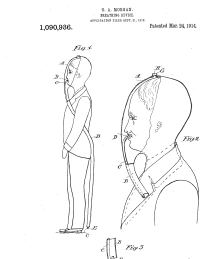Garrett Morgan
Inventor and entrepreneur Garrett Augustus Morgan pioneered important inventions including the “safety hood” — the forerunner of the gas mask — and the mechanical three-way traffic signal.
Born in Paris, Kentucky, in 1877, Morgan was the seventh of 11 children, and he grew up working on his family farm. In 1891, as a teenager, he moved to Cincinnati in search of better educational and financial opportunities. He soon found a job as a handyman, and he used some of his earnings to hire a tutor and continue his education.
After spending four years in Cincinnati, in 1895 Morgan moved to Cleveland, where he took a job sweeping floors at the Roots and McBride Co. Over time, he grew familiar with the company’s sewing machines, teaching himself how to operate and repair them. Not only did Morgan become a skilled machinist, but he also found inspiration for his first invention — a belt fastener for sewing machines.
In 1907, Morgan started his own business where he repaired and sold sewing machines. Two years later he opened a tailor shop: The Morgan Skirt Factory. While his wife Mary sewed clothes, Morgan built and maintained the sewing machines. He also began experimenting with a liquid for polishing sewing machine needles, preventing them from burning fabric as they sewed. When he discovered the liquid also could straighten hair, he used it to develop a hair cream, and he soon established the G. A. Morgan Hair Refining Co. Morgan then began investing his profits into developing more inventions.
Morgan found the motivation to develop one of his most impactful inventions when he learned about the devastating Triangle Shirtwaist Co. fire that caused the deaths of 146 garment workers in New York City in 1911. Understanding that the firefighters had struggled with smoke inhalation, Morgan began to devise a solution. In 1912, he filed for a patent on his breathing device, a “safety hood” that was designed to give a first responder the ability to “supply himself at will with fresh air from near the floor [and] at the same time forcibly remove smoke or injurious gases from the air tube.” Two years later, he established the National Safety Device Co.
In 1916, the importance of Morgan’s safety hood invention was demonstrated at the site of a tragic accident in Cleveland. Following an explosion at the Cleveland Waterworks that killed 18 workers, survivors were trapped as a gas-filled tunnel collapsed under Lake Erie. Without effective safety equipment, rescuers had been unable to reach them because smoke, dust and fumes blocked their way. But when some volunteers — including Morgan himself — put on safety hoods, they were able to successfully reach and rescue several survivors.
Despite his invention’s obvious lifesaving potential, Morgan found difficulty in selling his safety hood to white fire chiefs who refused to buy products from a Black inventor. In response, Morgan sought the advice of the famous entrepreneur J.P. Morgan, who suggested he remove his first name from the product. Following this advice, the inventor began calling his device the “Morgan Safety Hood.” He also hired white actors to promote the product at conventions, helping him to avoid racist objections. Morgan’s new marketing strategies worked, and fire departments across the country finally began to buy his early gas masks.
By the 1920s, Morgan had established himself as a successful businessman and had purchased an automobile. While driving through Cleveland one day, he witnessed a collision between a horse-drawn carriage and another vehicle at an intersection. This experience compelled Morgan to once again use his talents and skills to develop an invention that would improve the safety and welfare of his fellow citizens.
Though rudimentary traffic lights existed at the time, they only displayed two signals: stop and go. Recognizing the need for better traffic control on congested city streets, Morgan created a revolutionary T-shaped signal that included a “caution” light — the equivalent of today’s yellow light.
Morgan patented his three-way traffic signal in 1923. According to his patent, his hand-operated signal stopped traffic “in all directions before the signal to proceed in any one direction is given.” This allowed vehicles that were already in an intersection to safely pass through it without the risk of collision. He sold his patent rights for $40,000 to General Electric, and the company developed an electric version of his three-way traffic signal.
Having been an advocate for racial equality throughout his life, Morgan formed one of the first Black fraternities in the country at Cleveland's Western Reserve University. In 1963, he was honored as a pioneering citizen at the Emancipation Centennial Celebration for his essential contributions to public safety and his legacy of perseverance, ingenuity and problem solving for the common good.
